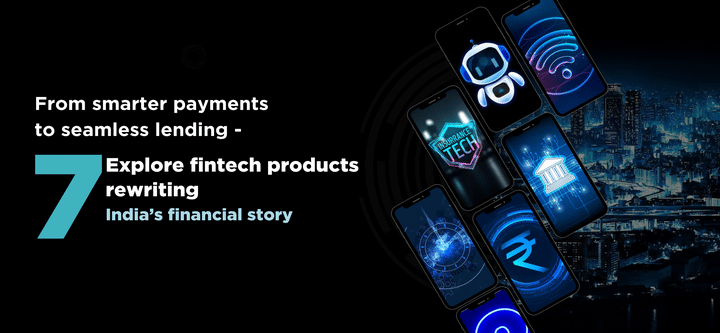India is witnessing an unprecedented surge in fintech innovation, a revolution that is reshaping the financial landscape of the nation. With a growing digital economy, the Indian fintech market is expected to reach $1.3 trillion by 2025, driven by the adoption of advanced technologies and a favourable regulatory environment.
From streamlining payments to enhancing financial literacy, fintech products have become indispensable to India’s economic fabric. In this blog, we explore the top seven fintech products that are revolutionizing India in 2025.
1. Digital Payments: UPI and Mobile Wallets – A Cashless Symphony
India’s digital payment ecosystem, led by UPI (Unified Payments Interface), has become the gold standard for instant, seamless transactions. The Unified Payments Interface (UPI) was the dominant payment system in India in the first half of 2024, with over 78 billion transactions, demonstrating its widespread acceptance across urban and rural areas alike.
Mobile wallets like Paytm, PhonePe, and Google Pay continue to complement this growth by offering loyalty programs, seamless bill payments, and integration with e-commerce platforms.
Why it Matters:
- UPI’s integration with cross-border payments allows NRIs and international businesses to transact effortlessly.
- The Reserve Bank of India (RBI) has projected that digital payments will constitute 60% of all retail transactions in India by 2030.
Evolute’s secure payment solutions ensure businesses can seamlessly adopt digital payment systems, catering to India’s vast unbanked population.
2. Lending Platforms: Instant Credit for Everyone – Bridging the Credit Gap
India’s digital lending platforms, including KreditBee, MoneyTap, and Bajaj Finserv, are revolutionizing access to credit, making borrowing simple, inclusive, and quick. By leveraging advanced technologies like AI, these platforms are empowering individuals and businesses, including those traditionally excluded from formal credit systems.
According to a 2024 report by CRIF High Mark, India’s digital lending sector grew by 45% year-on-year, with fintech lenders disbursing ₹2.5 trillion in loans.
Why it matters
- Digital lending platforms are bridging the credit gap for over 190 million unbanked adults in India (Global Findex Database).
- AI and machine learning help assess alternative data, allowing those without credit histories to access loans.
- These platforms support SMEs, which contribute to over 30% of India’s GDP, addressing the unmet credit needs of more than 70% of them (RBI).
These platforms leverage AI to assess creditworthiness, enabling even those without a credit history to access loans.
3. Wealth Management: Robo-Advisors for Beginners – Democratizing Investments
India’s wealth management landscape has undergone a significant transformation, with robo-advisors like Groww, Zerodha, and ET Money leading the charge. These platforms make investment accessible by offering personalized, data-driven portfolio management that appeals to first-time investors and seasoned users alike.
Why it matters
- Robo-advisors simplify investing with AI, making it accessible to individuals across income levels, even without extensive financial knowledge.
- The Indian mutual fund industry’s AUM reached ₹68.08 trillion (USD 0.82 trillion) by November 2024, with robo-advisors gaining traction due to their affordability and ease of use (AMFI).
- A significant portion of robo-advisory users are millennials, mostly between 25 and 35, representing a shift toward digital wealth management.
Robo-advisors eliminate traditional biases with data-driven decisions, enabling millions to invest efficiently through automation and scalability, advancing financial inclusion in India.
4. Insurance Tech: Simplifying Policy Purchases – Ensuring a Safer Tomorrow
Insurance technology (InsurTech) platforms like Policybazaar and Acko have revolutionized how Indians purchase, compare, and claim insurance policies. By harnessing AI and machine learning, InsurTech is delivering personalized plans and reducing claim processing times.
A survey by IRDAI reveals that over 55% of insurance purchases now occur digitally, compared to 30% in 2020. Instant policy issuance and predictive analytics for risk assessment are two standout features that make InsurTech invaluable.
Why it matters
- India’s insurance penetration is 4.2%, much lower than Taiwan’s 20%, but insurtech platforms are improving access, especially in rural areas (Mordor Intelligence, Nova Benefits).
- Platforms like PolicyBazaar and Acko provide affordable, tailored insurance, addressing post-pandemic surges in demand for health and life coverage (Nova Benefits).
- AI and digital tools streamline claims and policy issuance, boosting trust and convenience, which encourages first-time buyers (Mordor Intelligence).
AI and data analytics are transforming insurance by streamlining underwriting, improving risk assessment, and personalizing products. Acko uses these to offer instant policy issuance and claims settlement, building trust in digital insurance.
5. The Rise of Super Apps: All-in-One Solutions for the Digital Economy
Super apps are rapidly transforming India’s digital ecosystem, offering users an integrated experience where multiple services are accessible through a single platform. Apps like Paytm, PhonePe, and Google Pay have expanded beyond their core functionalities of payments to provide services ranging from food delivery and e-commerce to financial services, insurance, and even ride-hailing.
This evolution is significantly changing how Indians interact with technology, fostering a more connected and seamless experience.
Why it matters:
- Super apps like PhonePe consolidate multiple services, such as payments, bookings, and investments, simplifying tasks and driving adoption in smaller towns and rural areas.
- Super apps offer banking, insurance, and investment services to the unbanked and underbanked. PhonePe, for example, processed ₹9 trillion in transactions in 2023, shaping India’s financial landscape.
- Super apps use AI and data to offer personalized financial products and promotions, improving user engagement and helping businesses target customers effectively.
Super apps bridge the digital divide by offering a variety of services in one place, enhancing accessibility and saving time. Google Pay and PhonePe have gained trust across India by providing regional language support and user-friendly interfaces, successfully reaching diverse socio-economic groups.
6. Neobanks: Redefining Traditional Banking Services – A New Way to Bank
Neobanks in India, including platforms like Jupiter, Fi Money, and RazorpayX, are rapidly transforming the banking sector by offering digital-only, mobile-first banking solutions. These neobanks provide everything from current and savings accounts to budgeting tools and lending services without the need for traditional brick-and-mortar branches.
A PwC report states that the Indian neobank market is set to grow at a CAGR of 54.5%, reaching $20 billion by 2027. Neobanks cater to freelancers, SMEs, and millennials, making banking inclusive and user-friendly.
Why it matters:
- Neobanks bridge the rural financial gap, with 80% of rural India having access to formal banking (RBI), using mobile-first solutions for easier access.
- Neobanks offer low-cost services, fast transactions, and real-time approvals, addressing India’s financial access challenges.
- Neobanks use AI to personalize financial services, tailoring credit and budgeting tools based on individual spending habits.
Neobanks are driving India’s digital banking transformation by offering lower-cost financial products with greater efficiency. Their innovative approach is reshaping customer experiences and providing financial services to those excluded by traditional banking systems.
7. Financial Literacy Apps: Educating the Masses – Knowledge is Wealth
Financial literacy has become a fundamental component of India’s fintech revolution, thanks to the rise of apps that make financial education accessible to the masses. Platforms like Zerodha Varsity, Cube Wealth, and Moneybhai are at the forefront of this movement, providing a wealth of educational content on budgeting, investing, taxation, and more.
A survey by the National Centre for Financial Education (NCFE) revealed that 70% of Indians improved their financial knowledge through these apps, up from 55% in 2023.
Why it matters
- Over 50% of India’s population remains underserved or unaware of personal finance. Digital platforms are bridging this knowledge gap.
- Better Financial Decisions: These platforms help users make better decisions, leading to improved savings, investment habits, and overall financial inclusion in a country where financial knowledge has been unevenly distributed.
Evolute’s Initiative: By collaborating with literacy platforms, Evolute empowers individuals and businesses to make informed financial decisions.
Other FinTech Developments in India
- Challenger DFS Platforms: Operate under traditional banks, providing innovative and user-friendly financial services at lower fees.
- Digital Banking Integration: Public sector banks enhance customer experience with various financial and lifestyle services.
- Investment Trends: FinTech funding in India reached approximately USD 2.8 billion in 2023, ranking third globally.
- Regulatory Landscape: Evolving regulations by RBI, SEBI, and others support FinTech growth while ensuring consumer protection.
- Digital Transformation: Increased smartphone usage and digital payment platforms drive the growth of digital transactions, which are projected to reach USD 10 trillion by 2026.
FinTech Trends and Products
- Technological Innovations: Key trends include AI integration for fraud detection and personalised services, blockchain for secure transactions, and IoT for enhanced customer experiences.
- Investment Focus: Significant investments in AI-powered solutions (over USD 12.1 billion in 2023) and digital lending, with a growing emphasis on accessible financial services.
- Emerging Themes: Trends such as inclusion, green finance, ecosystem banking, and alternative investments are shaping the future of FinTech, targeting underserved populations and promoting sustainable practices.
The Road Ahead: Future of Fintech in India
India’s fintech revolution is far from over. With advancements in AI, IoT, and 5G, the possibilities are endless. Here’s what lies ahead:
- Hyper-Personalization: Fintech products will increasingly cater to individual preferences.
- Rural Penetration: With over 65% of India’s population in rural areas, the next big challenge is digital financial inclusion.
- Regulatory Support: Government initiatives like Digital India and the Fintech Sandbox are laying a robust foundation for innovation.
Key Takeaways
- Digital payments, lending platforms, and robo-advisors are driving India’s fintech revolution.
- Emerging technologies like blockchain and AI are enhancing security and user experiences.
- Financial literacy apps and neobanks are democratizing access to financial services.
- Evolute Group continues to play a pivotal role in enabling businesses to embrace fintech innovations effectively.
India’s fintech journey is a testament to the transformative power of technology and innovation. As we look ahead, the synergy between digital solutions and user-centric designs will continue to shape the nation’s financial future.
For businesses seeking to ride the fintech wave, Evolute Fintech offers cutting-edge solutions tailored to the unique needs of the Indian market. Let’s innovate together for a brighter tomorrow!





